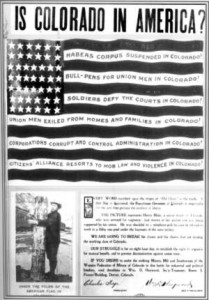Review by Ed Quillen
Mining lore – August 2003 – Colorado Central Magazine
Drills and Mills – Precious Metal Mining and Milling Methods of the Frontier West
by Will Meyerriecks
Published in 2001 by the Author
ISBN 0-9714383-0-7
NO ONE WILL DISPUTE the importance of mining to the history of Central Colorado, but most histories treat the subject only in passing. That is, they announce that major discoveries of silver were made in Leadville in 1877, then proceed to detail the excitement and violence of a boom town. Seldom do they mention just what was happening on Fryer Hill, unless it involved some labor warfare. We’re left to wonder just what happened after a miner left for work in the morning.
There are some exceptions to this — Steve Voynick’s Leadville: A Miner’s Epic explains underground life and technology from the vantage of the working miner who faced death or dismemberment every hour of every shift.
And there was more to the mining industry than just getting rocks out of the ground. From the mine portal, the ore had to be crushed and concentrated, then further refined with heat and chemicals. The route from silver mine to silver dollar could be long, and dangerous to the workmen at every step. It’s hard to understand the history without some knowledge of that route, and yet the full process seldom appears in print in a way that is accessible to the general reader.
Thus Drills and Mills is more than welcome. It covers just about every aspect of the process of mining in the Old West, from simple placer operations to the chemistry of smelting. It is copiously illustrated, and in general, the explanations are clear enough to be understood even by an English major.
Since I have a few books about the internal operations of hard-rock mines, I found the milling and smelting chapters of this book the most interesting, since they provided the most new information.
I had some vague knowledge that once the rock moved into the ore carts, it then had to be crushed. But much more happens after that. Generally it is ground into a fine powder, which is then treated with chemicals. The resulting compounds go to a smelter, which applies heat and chemicals to produce a relatively pure flow of gold or silver.
But now I know how stamp mills, arrastras, and jaw crushers worked. I marvel that any trees grow in any old mining area after reading about amalgamation (mercury has an affinity for fine particles of gold and silver) and roasting (heating the amalgam to drive off the toxic mercury, which soon condensed nearby). And if mercury wasn’t dangerous enough, the industry also offered chlorine and cyanide, all to retrieve the gold and silver from various natural compounds.
This is the first place I’ve ever found a sensible explanation of what happened inside smelters, and the book doesn’t stint in its coverage of regular mining, from bucket dredges on the surface to the stopes, winzes, and square sets underground. It also goes into the economics of frontier mining — the costs of materials and transportation, of labor and energy. The author’s examples come from throughout the West, but since Colorado was such a major mining state then, it gets considerable mention.
Will Meyerriecks obviously has a consuming interest in his topics, but he is hardly an uncritical chronicler. He explains the dangers, both to workers and the environment, in the technology and processes, and he also quotes often from 19th-century sources — thereby demonstrating that people knew better at the time.
Meyerriecks book is well indexed with copious source notes, and still quite readable; here’s the start of the section about timbering:
“As the miners sunk shafts, advanced drifts, raises and crosscuts, and mined ore from the stopes, support of the surrounding rock was often necessary. Unsafe rock is generally referred to as bad ground. The different methods of timbering that were developed had as their primary goal the safety of the miner.1
“Other benefits, and dangers, for the miners were often direct side effects of the various timbering strategies used. The reader should appreciate that none of the timbering schemes ever developed will support a mountain if it wants to move; a zillion tons of rock does what it likes, and no arrangement of match sticks is going to stop it.”
And now for that note: “1 In many mines, the primary goal seems to have been keeping the workings open for exploitation. Safety for the miners appears secondary. Crampton [Frank A. Crampton, author of A Working Stiff in the Western Mining Camps] experienced this first-hand, and was even warned about the mine he went to work in: ‘Down there men are cheaper than timber.'”
So if you’ve ever had reason to wonder about stulls and cribbing, or chlorination and roasting, or Wilfley tables (used at Climax) and Burleigh drills — this is the book you need. It explains a big chunk of our history that is often ignored.
— Ed Quillen


